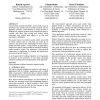Free Online Productivity Tools
i2Speak
i2Symbol
i2OCR
iTex2Img
iWeb2Print
iWeb2Shot
i2Type
iPdf2Split
iPdf2Merge
i2Bopomofo
i2Arabic
i2Style
i2Image
i2PDF
iLatex2Rtf
Sci2ools
80
Voted
APSEC
2000
IEEE
2000
IEEE
Enterprise modeling using class and instance models
Current object-oriented formalisms, such as UML, focus on describing class models and use instance models only for depicting scenarios. Little attention is being devoted to defining how complex systems can be structured in order to conform with those class models and, further, which constraints class models must adhere to so that such conformity is affordable. This paper focuses on instance models, which are models of actual systems and as such they are made up of instances, and discusses the relationships between instance models and class models. A large number of applications, ranging from generic data modeling to enterprise modeling, require instance models. The importance of hierarchical composition is emphasized: its meaning and implications are discussed in both contexts. A novel approach for building templates out of aggregates of instances is also presented. A case study concerning enterprise modeling shows the application of the approach. Keywords Object-oriented modeling, en...
Related Content
| Added | 30 Jul 2010 |
| Updated | 30 Jul 2010 |
| Type | Conference |
| Year | 2000 |
| Where | APSEC |
| Authors | Rakesh Agarwal, Giorgio Bruno, Marco Torchiano |
Comments (0)

